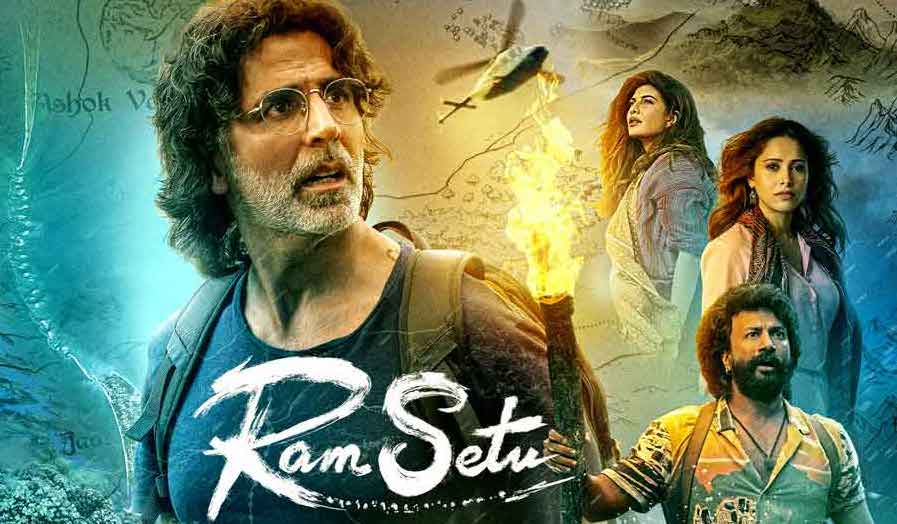Abhishek Sharma’s ‘desi’ version of Indiana Jones, Ram Setu (2022), explores the journey of an atheist and archaeologist, Dr Aryan Kulshrestha (Akshay Kumar), as he sets out to prove that the existence of Lord Rama is no more than a mythical tale and does not hold any scientific ground whatsoever. In keeping with the current mood of the country and its hero’s image, he naturally, in the course of the film, manages to prove the omni presence of the divine and through it, discovers his faith in the almighty!
The film begins Aryan’s trip to the Bamiyan, to save what little remains of the Buddhist legacy in the region. When he and his associates from Pakistan, Afghanistan, and China are attacked by Taliban militia, Ayan put his life at risk to save coins, necklaces and other jewelry that were hidden underground by an ancient Hindu king. His heroism and act of bravery is appreciated by the government of both Pakistan and India. Meanwhile, a shipping company tycoon, Indrakant (Nasser), has constructed a high-tech ship that consumes lots of fuel and requires an alternate route to minimize the distance covered by his vessel. So with support from the ministers in power, he decides to demolish the ‘Ram Setu’ bridge linking India and Sri Lanka to facilitate his business with other countries. Naturally, there is a nationwide protest from various sections of Hindu society. The Supreme Court of India steps in to pass an order that halts the razing of the bridge. Indrakant and the Archaeologist Survey of India (ASI) ask Aryan to prove that this bridge is a man-made structure so Indrakant can proceed with its destruction.
Ram Setu is a ‘motivational entertainer’ that makes a sweeping attempt to make viewers believe in the greatness of the Hindu religion. In fact, the film appears to be a propaganda manifesto for Hinduism, disguised in the cloak of filmmaking. The tone is set right from the beginning through an argument between Aryan and his professor-wife Gayatri, wherein the latter tries to convince her husband that the validity of existence of Lord Rama is based on people’s deep, spiritual faith. As the narrative moves forward, such devotional preachiness is repeatedly forced on us. Nowhere is this more evident than in the climactic courtroom scene, which seems to be in the film solely to provide Aryan a solid platform to deliver a whistle-inducing speech in favour of Hinduism.
Ram Setu‘s screenplay is shoddily written as it is filled with one plot point after the other that all-too-conveniently solves the various hurdles that Aryan faces as much as a snap of the fingers. Naturally, charaterizations and logical character arcs take a back seat to the film’s flimsy storytelling. Aryan’s major transition from a total non-believer to a devout one is far too sudden for it to be convincing. Though Sharma along with his co-dialogue writer, Dr Chandra Prakash Dwivedi, attempts to add ‘intelligence’ and an element of ‘research’ in their script by mentioning Pushkar Bhatnagar’s seminal book, Dating The Era of Lord Ram, the screenplay remains superficial and devoid of any depth whatsoever.
In terms of performances, Akshay Kumar, except for wearing a pair of spectacles and sporting a salt and pepper beard, does nothing more or unexpected with the role. A Harrison Ford he certainly isn’t, not even close! The two leading women of the film, Nushrratt Bharuccha and Jacqueline Fernandez, are, sadly, totally wasted, highlighting once again how unimportant women are in the scheme of things in mainstream Indian cinema. Just making them a professor or an environmentalist is mere tokenism. Nasser and Pravesh Rana perform their roles as antagonists in a typically clichéd manner adding nothing to the film. Only Satyadev Kancharana as Anjaneyan Pushpakumaran aka AP brings much-needed comic relief as well as some emotional heft into the film.
The technicals don’t help either. The cinematography (Aseem Mishra) fails to add any psychological or emotional depth while the editor (Rameshwar S Bhagat) struggles to develop a rhythmic flow within the extremely choppy narrative. The VFX team delivers a mediocre output as the CGI-generated images – especially those of the choppers – reek of rank amateurishness. The booming background score by Daniel B George, filled with rousing religious chanting during the key dramatic moments, successfully creates nothing but noise. Even the action sequences – with the many chases and narrow escapes – fail to provide the desired edge-of-the-seat thrills.
All in all, Ram Setu is neither entertaining as a thrilling adventure nor is it clever or deep enough to engage a serious discourse between religious faith and scientific logic. It is a wholly uninvolving drama that has little going for it and for us, the viewers.
Action, Adventure, Drama, Color


